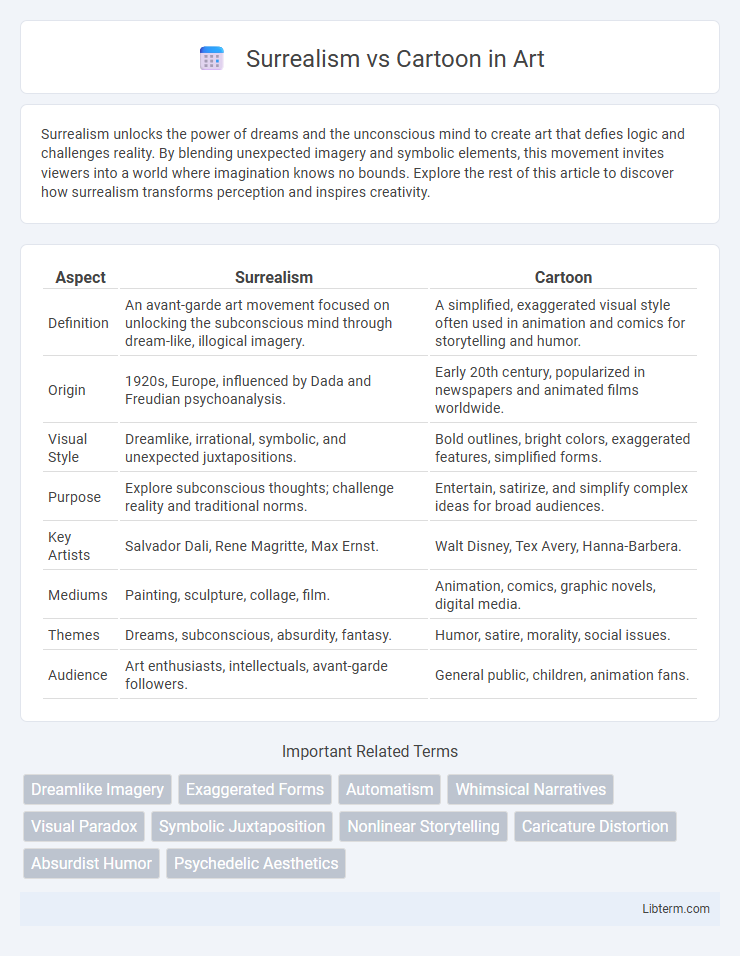Surrealism unlocks the power of dreams and the unconscious mind to create art that defies logic and challenges reality. By blending unexpected imagery and symbolic elements, this movement invites viewers into a world where imagination knows no bounds. Explore the rest of this article to discover how surrealism transforms perception and inspires creativity.
Table of Comparison
| Aspect | Surrealism | Cartoon |
|---|---|---|
| Definition | An avant-garde art movement focused on unlocking the subconscious mind through dream-like, illogical imagery. | A simplified, exaggerated visual style often used in animation and comics for storytelling and humor. |
| Origin | 1920s, Europe, influenced by Dada and Freudian psychoanalysis. | Early 20th century, popularized in newspapers and animated films worldwide. |
| Visual Style | Dreamlike, irrational, symbolic, and unexpected juxtapositions. | Bold outlines, bright colors, exaggerated features, simplified forms. |
| Purpose | Explore subconscious thoughts; challenge reality and traditional norms. | Entertain, satirize, and simplify complex ideas for broad audiences. |
| Key Artists | Salvador Dali, Rene Magritte, Max Ernst. | Walt Disney, Tex Avery, Hanna-Barbera. |
| Mediums | Painting, sculpture, collage, film. | Animation, comics, graphic novels, digital media. |
| Themes | Dreams, subconscious, absurdity, fantasy. | Humor, satire, morality, social issues. |
| Audience | Art enthusiasts, intellectuals, avant-garde followers. | General public, children, animation fans. |
Understanding the Essence: What is Surrealism?
Surrealism is an avant-garde artistic movement that explores the unconscious mind through dream-like, fantastical imagery, often defying logical conventions. Unlike cartoons, which prioritize humor, simplicity, and exaggerated characters for entertainment, surrealism challenges reality with symbolic, abstract, and sometimes disturbing visuals. The essence of surrealism lies in its ability to juxtapose unexpected elements, revealing deeper psychological truths beyond the surface.
Defining Cartoon Art: Characteristics and Evolution
Cartoon art is characterized by simplified, exaggerated features, bold lines, and vibrant colors that emphasize humor, satire, and storytelling. Its evolution traces back to early political cartoons and comic strips, progressing through animation and graphic novels, reflecting cultural and social narratives. Surrealism contrasts by exploring dream-like, bizarre imagery that challenges reality, while cartoons prioritize clarity and accessibility through stylized visuals.
Historical Origins: Surrealism and Cartoon Compared
Surrealism emerged in the early 1920s as an avant-garde movement rooted in the works of Andre Breton, emphasizing dreamlike, unconscious imagery inspired by Freudian psychoanalysis. Cartoons, dating back to the late 19th century with newspapers' political and satirical illustrations, developed as simplified, exaggerated visual art forms aimed at humor and social commentary. While Surrealism sought to explore the subconscious through symbolic and illogical scenes, cartoons prioritized accessibility and direct communication through caricature and sequential art.
Visual Language: Symbolism vs Exaggeration
Surrealism employs visual language rooted in symbolism, using dreamlike imagery and unexpected juxtapositions to convey complex psychological and philosophical concepts beyond ordinary reality. Cartoon art emphasizes exaggeration, utilizing distorted proportions and expressive gestures to deliver humor, emotion, and simplified narratives that are immediately accessible. Both styles manipulate visual elements deliberately but serve distinct communicative purposes through their unique approaches to representation.
Influential Artists: Surrealists and Cartoonists
Salvador Dali and Rene Magritte are seminal figures in Surrealism, renowned for their dreamlike, bizarre imagery that challenges reality and perception. In the realm of cartoons, Walt Disney and Chuck Jones revolutionized the medium with iconic characters and innovative animation techniques, blending humor and storytelling. Both Surrealists and cartoonists significantly influenced visual culture by pushing creative boundaries and inspiring future generations of artists.
Narrative Approaches: Dream Logic vs Humor
Surrealism employs dream logic to craft narratives that defy conventional reality, often blending unexpected elements to evoke subconscious emotions and challenge perceptions. Cartoon narratives rely on humor, using exaggerated characters, slapstick scenarios, and timing to create lighthearted, accessible stories. While surrealism invites introspection through abstract symbolism, cartoons prioritize entertainment through comedic storytelling techniques.
Expression of Reality: Subconscious vs Satire
Surrealism delves into the subconscious, using dreamlike imagery and irrational scenes to express hidden emotions and deeper realities beyond logical perception. In contrast, cartoons employ satire and exaggeration to reflect and critique social realities, often distorting facts for humorous or critical effect. Both forms challenge conventional views of reality, but surrealism explores internal experiences while cartoons comment on external society.
Techniques and Mediums: Surrealist vs Cartoon Styles
Surrealism employs techniques like dream-like imagery, automatism, and unexpected juxtapositions using mediums such as oil paints, collage, and mixed media to evoke the unconscious mind. Cartoon styles rely on exaggerated lines, simplified shapes, and vibrant colors through mediums including ink, digital illustration, and animation to convey humor and narrative clarity. Both styles utilize distinct techniques and mediums that reflect their unique artistic goals--Surrealism's exploration of the subconscious contrasts with the cartoon's emphasis on accessibility and storytelling.
Impact on Popular Culture: Surrealism vs Cartoon Art
Surrealism profoundly influenced popular culture by inspiring avant-garde films, fashion, and advertising with its dreamlike visuals and symbolic imagery, challenging conventional perceptions of reality. Cartoon art, characterized by bold lines and exaggerated features, became a cornerstone of mass entertainment through animation, comic strips, and merchandising, shaping humor and storytelling for global audiences. Both movements transformed visual culture, but surrealism appeals to niche artistic sensibilities, while cartoons have created accessible icons embedded in everyday life.
Modern Interpretations: Blending Surrealism with Cartoons
Modern interpretations blend surrealism with cartoons by integrating dreamlike, abstract elements into vibrant, exaggerated characters, creating visually striking narratives that challenge reality. Artists use distorted proportions, unexpected juxtapositions, and symbolic motifs native to surrealism within the playful, accessible style of cartoons to evoke emotional depth and imaginative exploration. This fusion revitalizes both genres, expanding the creative possibilities and appealing to diverse audiences in contemporary visual culture.
Surrealism Infographic

 libterm.com
libterm.com